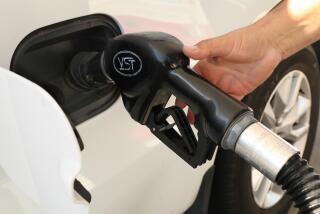Gasoline Rip-Offs Are Difficult to Detect
- Share via
It’s surprising how many people suspect their gas station of “watering the gas.” Others suspect that they were cheated because their gas gauge should have moved further for the amount of gas pumped. Still more drive away from stations offering discounts for cash with a sum of money that just doesn’t seem right.
Could be. Nobody really “waters” gas, but there are other possible abuses, including falsified octane ratings, short measures of gas, inflated charges. Inherently complicated, gasoline sales involve multiple pumps, multiple prices, and arithmetic that requires a calculator. Only later, given receipts and time to check them, can the consumer catch the fact that his station charged $17.70 for 12.4 gallons of unleaded at $1.399, when the total should have been $17.35, and $17 (not the correct $16.69) for 12.1 gallons at $1.379.
The tradition of adding .9 to every price adds complication, as does an unusually large spread between self-serve and full-serve prices (service shouldn’t cost 40 cents a gallon, say insiders), and instant cash discounts. “The consumer could get ripped off right and left,” says Steve Shelton, executive director of the Southern California Service Station Dealers Assn., “but he has the power to police the marketplace.”
Not always. The consumer can’t really analyze the content of his gas, particularly the octane rating that distinguishes regular from premium gasolines. Indeed, a recent report from the General Accounting Office found octane rating misrepresented in about 9% of gas samples nationwide and in more than 50% of samples from some states.
Under the Petroleum Marketing Practices Act of 1978, the EPA and FTC are responsible for making sure consumers get accurate information about octane ratings, but if they ever started testing and enforcing, they stopped some years ago, says the GAO. It may even be understandable: Mislabeling is less likely to occur at refineries or bulk terminals, where it’s constantly tested, than at wholesale or retail outlets; enforcement must, therefore, be local.
But local action isn’t guaranteed: Only 20 states have their own octane-testing programs. In California, for example, the state Food and Agriculture Department’s division of measurement standards has gasoline-testing labs in Sacramento and Anaheim. The bureau picks up samples in response to consumer complaints, does some random sampling, and every five years, does a statewide survey of stations.
Local authorities do more regular station inspections, checking everything from the accuracy of the price signs to the anti-drain valves on nozzles. At that, they cover large areas. Los Angeles County’s Department of Weights and Measures inspects 3,400 stations and 42,000 “nozzles,” with six inspectors. New York City’s Consumer Affairs Department covers all five boroughs, its five inspectors checking over 14,000 pumps last year at 1,600 gas stations.
It’s a myth that sophisticated inspectors can judge octane rating just by the color of the gas. Those they inspect are also sophisticated: “They get wise to us and compromise the color,” says Bob Kelley, deputy director of enforcement for New York City’s Consumer Affairs Department. But given complaints, or their own suspicions that “the price isn’t right, and the color’s off,” they take samples for lab testing.
The measure of gas pumped and the charge are another problem. “People automatically assume the amounts on the pump are going to be right,” says Joseph Jamora, division chief at Los Angeles County Weights and Measures.
But many pumps are still mechanical, even when the remote console at the cashier’s booth is electronic, and both the measure and the charge have to be set manually--every time the price changes. Given the likelihood of manual error, one pump off out of 12 is considered forgivable, but 3 out of 12 would be unacceptable.
Inaccuracies in the volume of gas pumped are usually just “sloppy housekeeping,” says Kelley, and 65% of those inaccuracies actually come out in the consumer’s favor. But “when the charges are off,” he says, “it’s never in favor of the consumer.”
Inspectors generally visit unannounced, but are almost immediately identifiable: Few consumers pull out 5-gallon calibrated measures and start drawing off gasoline. California’s inspectors take 10 gallons worth to check the volume measure, then check the accuracy of the charge by multiplying the unit price by 10 and seeing if the price on the pump agrees with the answer.
The consumer could duplicate some of this routine, protecting himself at least against overcharges--one reason, perhaps, that in Kelley’s experience, overcharges are much rarer than octane misrepresentation. But few consumers are that methodical about their suspicions: They tend to go by the gauge, says Jamora, complaining that they seemed to get less than they paid for. And those who are least suspicious--a station’s loyal, regular customers--probably have most cause to be: “Smart people only steal from their known customers,” says Kelley.
Consumers can certainly guard against today’s most common cheat--by all accounts, a failure to give the promised cash discount. Some pumps register both cash and credit prices, but most show only credit price, leaving it to an attendant to calculate and hand back the difference. An inattentive customer may be handed the wrong change or be told that the stated price is already discounted, and a very inattentive customer may be told nothing at all.
But the gambit is easily foiled. Consumers (as if they didn’t have enough to watch for) need only ask.
More to Read
Sign up for Essential California
The most important California stories and recommendations in your inbox every morning.
You may occasionally receive promotional content from the Los Angeles Times.













